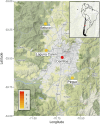Feather corticosterone levels in the southern lapwing revealed no association with the degree of urbanization
- PMID: 40092147
- PMCID: PMC11906661
- DOI: 10.3389/fphys.2025.1523983
Feather corticosterone levels in the southern lapwing revealed no association with the degree of urbanization
Abstract
The urbanization process modifies the environment in which wildlife lives. On the one hand, it modifies the biotic and abiotic elements and introduces new stress factors like light pollution, noise pollution, and chemical pollution. These modifications to natural elements and the introduction of new ones could induce stress in organisms and lead to the release of glucocorticoids. One taxonomic group that lives in cities and is highly sensitive to changes in habitat and human population density is birds. Most of the studies about stress and urbanization have measured glucocorticoids (GCs) circulating in the blood, which offer only a "snapshot" of an animal's current state, and it is affected by the capture procedure. An alternative is to measure GCs in samples that are not altered by the capture procedure, like feathers. In this study we compared levels of corticosterone in feather (CortFeather) of the southern lapwing (Vanellus chilensis) in four locations in the Metropolitan Region (RM) of Santiago de Chile. To accurately measure urbanization, we employed four distinct land cover typologies to illustrate the variations in structural characteristics. A 500-m buffer zone was created around each of the four collection sites where feathers were gathered, creating an "Urbanization score". We observed a statistically significant variation in the median CortFeather values across the four studied localities. Contrary to our expectation, the observed differences in CortFeather concentrations were identified not among the highly urbanized populations but rather between two populations characterized by lower urbanization scores. In the same line, we observed the absence of correlation between the "Urbanization score" and CortFeather levels. Our findings indicate that factors beyond those captured in the satellite images may contribute to the elevated levels of this hormone in a low urbanized wetland in the Santiago Metropolitan region of Chile. For instance, the prevalence of feral dogs in the vicinity, including within the wetland, could be a significant contributing factor.
Keywords: Vanellus chilensis; plovers; precocial; stress physiology; urban ecology.
Copyright © 2025 Quirici, Kilgour, Cuevas, Fletcher, Sarmiento, González-Lagos and Romero.
Conflict of interest statement
The authors declare that the research was conducted in the absence of any commercial or financial relationships that could be construed as a potential conflict of interest.
Figures



References
-
- Baudains T. P., Lloyd P. (2007). Habituation and habitat changes can moderate the impacts of human disturbance on shorebird breeding performance. Anim. Conserv. 10, 400–407. 10.1111/j.1469-1795.2007.00126.x - DOI
-
- Beaugeard E., Brischoux F., Henry P. Y., Parenteau C., Trouvé C., Angelier F. (2019). Does urbanization cause stress in wild birds during development? Insights from feather corticosterone levels in juvenile house sparrows (Passer domesticus). Ecol. Evol. 9, 640–652. 10.1002/ece3.4788 - DOI - PMC - PubMed
-
- Biamonte E., Sandoval L., Chacón E., Barrantes G. (2011). Effect of urbanization on the avifauna in a tropical metropolitan area. Land. Ecol. 26 (2), 183–194. 10.1007/s10980-010-9564-0 - DOI
LinkOut - more resources
Full Text Sources

